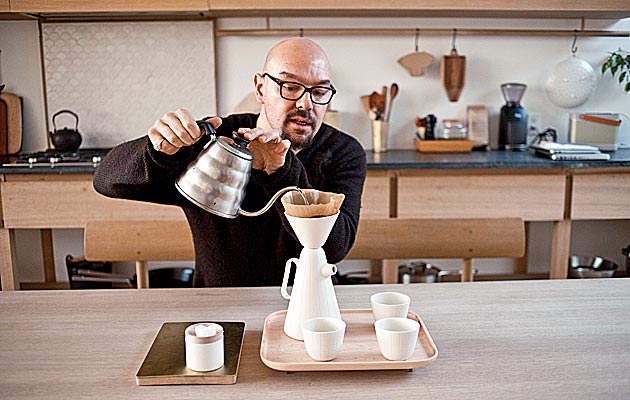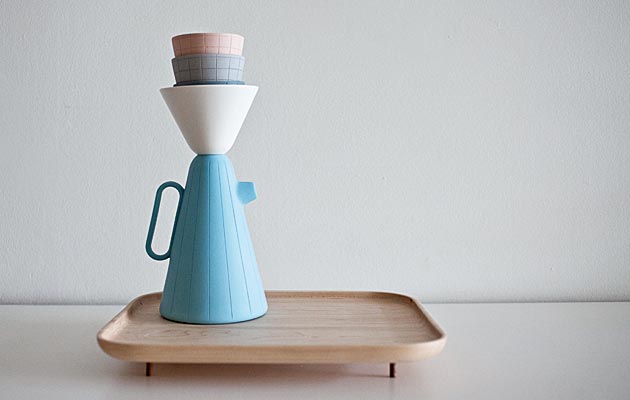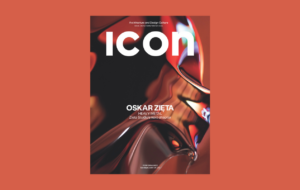|
Nichetto was inspired by tea-drinking ceremonies |
||
|
The Venetian designer sought to reinvent today’s frenetic coffee-drinking habits with a touch of ritual and contemplation The Sucabaruca coffee set by Venetian designer Luca Nichetto is a minimalist and elegant response to today’s global coffee-drinking culture. Launched at Stockholm Design Week earlier this year, it was commissioned by the owners of the Mjölk shop and gallery in Toronto, John Baker and Juli Daoust, after Nichetto paid an impromptu visit. The trio decided to release a follow-up to last year’s Ceremony tea set by Claesson Koivisto Rune. But, as an Italian, Nichetto was keen to design a product around coffee instead. Created in collaboration with New York-based Russian designer Lera Moiseeva, the project draws on influences from both designers’ home cities, such as Venice’s famous Caffè Florian. It combines them with the idea of more contemplative tea-drinking ceremonies to reinvent today’s frenetic coffee-drinking habits. According to Moiseeva, it invites the user to take time and savour the process of coffee-drinking. The return to an appreciation of the drink as a simple pleasure is reflected in the set’s simple form and tactile finish in ceramic and wood, which give traditional filter coffee a quality makeover. Developed with Canadian ceramicist Alissa Coe, Sucabaruca is made with a Canadian maple and hand-engraved to emphasise the uniqueness of the pieces. This hands-on production process, collaborating with the craftsman, is very important to Nichetto. “I love to work with industrial processes, but I really enjoy working with products connected with hand-craft,” he says. “A lot of things we do in the industrial process derive from hand-craft work – it’s a good exercise as a designer to have both. To be a designer you need to know process. If you don’t, you become just a stylist and the world is too full of stylists right now.” The minimalism of Sucabaruca belies another set of more specific influences that informed its design. The cone-shaped body is inspired by an Italian TV show character, while the moniker itself is taken from a Venetian rap song. The set’s three colour palettes (white, pastel and pop primaries), meanwhile, are inspired, respectively, by Belgian fashion designer Martin Margiela, Japanese architecture, and artist Jean-Paul Goude. If such a plethora of stated influences seems confusing, Nichetto shrugs off attempts to read too much into them. “There’s not always a why about things,” he explains. “For many years I was so into justifying what I was doing that all the time I had to find the right reason why. Right now, I don’t care. If I have a good idea or reference that I find interesting, I [use it].” Nichetto and Moiseeva are already working on their next project. Cheburashka is a set of tableware that takes its cues from traditional Russian black ceramics, produced with Russian company Dymov Ceramics. It will be shown at Milan Design Week alongside Sucabaruca in Nichetto’s Walk The Line exhibition at Spazio Rossana Orlandi. The future of design lies in this type of collaboration, believes Nichetto. “To share knowledge and opportunity helps the [design] community to grow in the right way,” he says. “Maybe it’s utopia. I don’t know, but we’ll see.” Although Nichetto values his upbringing in Murano, and the international influence that came with it, he holds no truck with any reverential generalisations of “contemporary Italian design”. “My blood is Italian, but ‘made in Italy’? Blah blah.” That focus belongs in the past, he says. “It is better to look to the future. This is why right now, I’m one of the few Italian designers that works in an international way.” |
Words Anna Richardson Taylor |
|
|
||
|
Sucabaruca is made with Canadian maple and is hand-engraved |
||



















